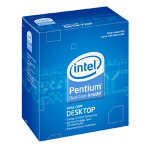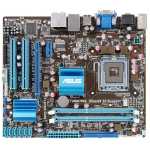System Buyers' Guide: PCs for Under $1000
by Sean Hollister on February 12, 2010 2:00 AM EST- Posted in
- Guides
Intel Entry-Level PC
From Pentium 4 to Pentium D, Core 2 Duo to Core 2 Extreme—not to mention the occasional Celeron and Xeon—Intel's LGA 775 socket has had a long, illustrious six years housing powerful processors. We're not going to write LGA 775's obituary quite yet, as Intel hasn't officially announced an end-of-life date for the aging socket. But with widespread availability of a mainstream successor in LGA 1156 and leaked Intel roadmaps depicting only the Pentium Dual-Core chips to continue through 2010, the writing's on the wall. If you buy an LGA 775 system today, don't expect to be able to easily upgrade its processor through retail channels next year.
However, none of that says an LGA 775 processor and motherboard can't be the base for a fantastic budget PC. LGA 775 chips have proven to be excellent overclockers, with many of the recent 45nm SKUs capable of reaching speeds up to 4GHz at stock voltage. They are mature and reliable; multiple AnandTech editors still use them in their home PCs, and clock for clock they continue to compete well against AMD's offerings (albeit at generally higher prices and/or lower core counts). And should you still want to upgrade at some point down the road, the aforementioned wide variety of compatible processors means that you may still find an opportunity to do so in the secondhand market.
| Intel Entry-Level System | ||
| Hardware | Component | Price |
| Processor | Intel Pentium Dual-Core E5300 (2.6GHz x2, 45nm, 2MB L2 Cache) |
$65 |
| Cooling | CPU Retail HSF | $0 |
| Video | Onboard | $0 |
| Motherboard | ASUS P5G43T-M Pro LGA 775 Micro ATX | $80 |
| Memory | G.Skill Ripjaws 4GB DDR3-1600 F3-12800CL9D-4GBRL | $105 |
| Hard Drive | WD Caviar Blue 500GB WD5000AAKS | $54 |
| Optical Drive | Sony Optiarc Model AD-7240S-OB 24X DVDRW SATA | $28 |
| Audio | Onboard | $0 |
| Case | Cooler Master Centurion 5 CAC-T05-UW Mid Tower ATX | $55 |
| Power Supply | OCZ ModXStream Pro 500W ATX12V SLI Certified, CrossFire Ready, 80 PLUS Certified Modular Active PFC (before $25 Rebate) | $65 |
| Base System Total | $452 | |
| Display | ASUS VW193TR Black 19" 5ms Widescreen LCD (1440 x 900) | $120 |
| Speakers | Built-in Monitor | $0 |
| Input | Microsoft B2L-00045 Comfort Curve Black USB Keyboard and Optical USB Mouse - OEM | $22 |
| Operating System | Microsoft Windows 7 Home Premium OEM 1-Pack (for System Builders) | $105 |
| Complete System Total | $699 | |
| Plus Estimated Shipping (within Continental U.S.) | $715 | |
| Rebates | -$25 | |
| Final Total (less tax, if applicable) | $690 | |
 |
Since December 2008, our CPU of choice for the Intel Entry-level PC has been the excellent Pentium Dual-Core E5200 Wolfdale: a 2.5GHz, $64 processor that hit a sweet spot in the price/performance ratio that no other Intel chip could match. Today, we're going to stray ever so slightly from our previous recommendation and suggest you pick up its bigger brother, the 2.6GHz Pentium Dual-Core E5300 instead. Why? Simply put, the $65 E5300 is the exact same chip, but with a 13x multiplier that immediately makes it 100MHz faster—for only $1 more. And considering that 13x multiplier also means a higher maximum overclock than that of the 12.5x E5200, we believe that extra $1 is money very well spent.
It's also important to note that since late 2009, new E5300 processors have been shipping with Intel's Virtualization Technology, or VT-x. If you're hoping to run the Windows XP Mode under Windows 7 Professional/Ultimate, you'll need this feature and you won't find it on the E5200. You can indeed find VT-x on the cheaper $60 Celeron E3400, but only in exchange for a significant drop in performance. On the other hand, if you're looking to spend even more on a processor and don't plan to overclock, you might consider the 2.8GHz E6300 for $80, which has guaranteed VT-x support and a 1066MHz (vs. 800MHz) FSB speed.
 |
With LGA 775 fading from the public eye, it was imperative that we find as capable and upgradable a motherboard as we could fit into our budget while such boards were still to be found. To that end, we chose the ASUS P5G43T-M Pro. At only $80, the P5G43T-M Pro features both the Intel G43 GMCH as well as the ICH10 Southbridge, allowing for acceptable video playback with the X4500 IGP and plenty of storage options, including a single IDE header and six SATA 3Gb/s ports. The board supports all LGA 775 processors up to the Core 2 Extreme series, 8GB of DDR3-1333 memory, and has excellent connectivity with VGA, DVI and HDMI ports, six USB 2.0 ports, Gigabit LAN and Realtek ALC887 8-channel HD audio, in addition to combo PS/2 and optical S/PDIF audio out. Onboard, there's a single PCIe x16 slot, a PCIe x1 slot and two PCI slots, as well as headers for six more USB 2.0 ports. There's no hardware RAID support, only a single chassis fan connector and you won't be playing new games or natively decoding H.264/VC-1/MPEG2 streams with the integrated X4500 graphics, but the P5G43T-M Pro's got a pretty solid layout with room to grow.
All other components are the same ones chosen for our AMD Entry-level PC, up to and including that 4GB of G.Skill DDR3-1600 memory. Even for an LGA 775 rig—where the majority of affordable motherboards use DDR2—we felt it didn't make financial sense to go with the slower modules when quality DDR3 is available for a marginal price increase, and can be repurposed if/when you build your next PC. However, if you're looking to squeeze out every last drop of value, you can pick up low-end DDR2-800 memory instead as with our AMD build. In that case, our motherboard recommendation is the ASRock G43Twins-FullHD (a similarly featured G43/ICH10 Micro ATX with separate DDR2 and DDR3 slots and a DVI/DisplayPort riser card) for $75. Just be aware that the G43Twins-FullHD uses jumper settings for its memory divider, so you'll need to check the manual in order to properly set the board for your memory.










86 Comments
View All Comments
mfenn - Friday, February 12, 2010 - link
I would like to point out that, while I am a fan of quiet GPUs, I think you were referring to separate GPUs on page 5.Check out:
http://dictionary.reference.com/browse/discreet">http://dictionary.reference.com/browse/discreet
vs.
http://dictionary.reference.com/browse/discrete">http://dictionary.reference.com/browse/discrete
SeanHollister - Friday, February 12, 2010 - link
You're absolutely right, and in this particular context, "discreet" is quite inaccurate, as both the discrete GPUs I'm referring to have a fan while the onboard IGPs are cooled by passive means.Thanks, and I'll see if we can take care of the typo in a future revision.
JarredWalton - Friday, February 12, 2010 - link
Fixed. I guess I only saw one of the three uses on that page. :-|Mr Perfect - Friday, February 12, 2010 - link
Just thought I would throw this out there, but have you looked at a system as only the tower itself? Personally, I know a lot of people who don't start from scratch like that. They reuse the keyboard, mouse, monitor, and speakers. Sometimes even the case and PSU if they bought good ones. Doing that will put your $1000 upgrade into i7-860 with a 5850 territory.SeanHollister - Friday, February 12, 2010 - link
Personally, that's how I build all my home PCs (I don't even know how old my plain old vanilla CD drive is at this point) and we actually did consider something similar for this guide, but decided to go the traditional route in case buyers wanted recommendations for all the items in a complete setup.But since we also provide complete price breakdowns, those who want to can optionally pick and choose individual components from the list at their leisure.
hombre - Tuesday, March 23, 2010 - link
I did exactly that. I already have keyboard, mouse, and monitor, so I skipped those.I will probably upgrade to a new monitor in a few months in order to take advantage of a DVI connection rather than VGA. I'm a bit limited in how large (wide) a monitor I can use with my computer desk though, so I shall have to choose one that fits. (Or maybe it's time to upgrade my furniture too.)
rivethead - Friday, February 12, 2010 - link
As an alternative to the ASRock motherboard on the entry level list I'll suggest the MSI 785GM-E65. It's another mATX board that's a bit more expensive than the ASRock but packed with features.rivethead - Friday, February 12, 2010 - link
On the totals of each entry it says "less applicable taxes". I believe it should say "plus applicable taxes".Taxes. The only certainty in life, other than death!
JarredWalton - Friday, February 12, 2010 - link
It's a phrase meaning "this price doesn't include taxes", where "plus applicable taxes" might suggest to some that taxes are part of the price. We could say "not including sales tax" to make it clearer, I suppose, but I just went with Sean's phrase since I've seen it used that way before.rochlin - Friday, February 12, 2010 - link
Useful article but missing some stuff:Benchmarks: Why not benchmark these machines against each other?
How much more oomph do you really get? AMD vs Intel? Put your recommendations side by side.
Also, you need to "benchmark" your own skills. Compare your home built machine to a comparable Dell - with whatever their current sale is. The Dell i3 machine comes out much cheaper than yours (albeit sans extra vid card - but still it's like 750 w mon vs $950 for yours. That's something your readers ought to know.
Building a machine is NOT usually the cheap route anymore.